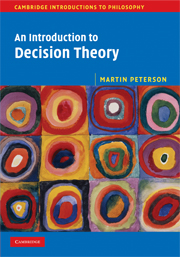Book contents
- Frontmatter
- Contents
- Preface
- 1 Introduction
- 2 The decision matrix
- 3 Decisions under ignorance
- 4 Decisions under risk
- 5 Utility
- 6 The mathematics of probability
- 7 The philosophy of probability
- 8 Why should we accept the preference axioms?
- 9 Causal vs. evidential decision theory
- 10 Bayesian vs. non-Bayesian decision theory
- 11 Game theory I: Basic concepts and zero-sum games
- 12 Game theory II: Nonzero-sum and cooperative games
- 13 Social choice theory
- 14 Overview of descriptive decision theory
- Appendix A Glossary
- Appendix B Proof of the von Neumann–Morgenstern theorem
- Further reading
- Index
Appendix A - Glossary
- Frontmatter
- Contents
- Preface
- 1 Introduction
- 2 The decision matrix
- 3 Decisions under ignorance
- 4 Decisions under risk
- 5 Utility
- 6 The mathematics of probability
- 7 The philosophy of probability
- 8 Why should we accept the preference axioms?
- 9 Causal vs. evidential decision theory
- 10 Bayesian vs. non-Bayesian decision theory
- 11 Game theory I: Basic concepts and zero-sum games
- 12 Game theory II: Nonzero-sum and cooperative games
- 13 Social choice theory
- 14 Overview of descriptive decision theory
- Appendix A Glossary
- Appendix B Proof of the von Neumann–Morgenstern theorem
- Further reading
- Index
Summary
Axiom: An axiom is a fundamental premise of an argument for which no further justification is given. Example: According to the asymmetry axiom, no rational agent strictly prefers x to y and y to x.
Bargaining problem: The bargaining problem is a cooperative game with infinitely many Nash equilibria, which serves as a model for a type of situation that arises in many areas of society: A pair of players are offered to split some amount of money between the two of them. Each player has to write down his or her demand and place it in a sealed envelope. If the amounts they demand sum to more than the total amount available the players will get nothing; otherwise each player will get the amount he or she demanded. The players are allowed to communicate and form whatever binding agreements they wish. A general solution to this problem was offered by Nash, who based his proposal on a small set of intuitively plausible axioms.
- Type
- Chapter
- Information
- An Introduction to Decision Theory , pp. 296 - 301Publisher: Cambridge University PressPrint publication year: 2009

